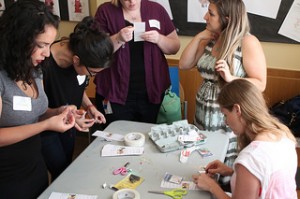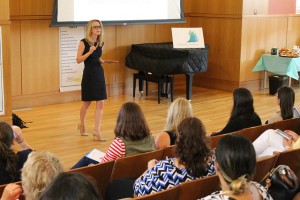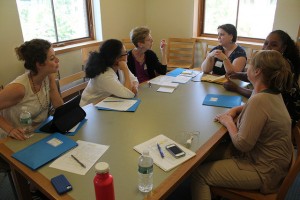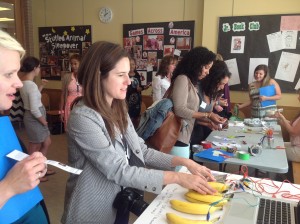Happy Campers: Librarians Discuss, Brainstorm, and Make at Annual KidLibCamp Unconference

KidLib Campers make LED "throwies" during the Make Break. Photo: Darien Library.
An energetic buzz was palpable at Darien (CT) Library on the morning of August 7 as almost 100 librarians gathered for the sixth annual KidLibCamp unconference. The free, daylong event has been offered every summer since 2009. Geared to public and school librarians from the New York, New England, and New Jersey areas, this fast-paced professional development day is hosted by Darien's children's librarians. The preparation begins several weeks before the event, as registered attendees submit discussion topic ideas via a shared Google doc. On the day of, the participants vote on the most popular themes, which then become breakout sessions facilitated and directed by the attendees.Participation over access
Kicking off the day was a keynote presentation by Lauren Britton, a 2013 LJ Mover & Shaker, leader in the makerspace movement for libraries, and current PhD. candidate at the Information Institute of Syracuse. Britton addressed the underlying philosophy of makerspaces and discussed the “mission problem” facing many public libraries. Using several unnamed library mission statements as examples, Britton argued that too many mission statements focus on access as the raison d’etre for library services. “I’m not saying access is not important,” explained Britton. “It is….But we’ve confused our tools of the trade for our reason for being.”
Lauren Britton discusses why creating a participatory culture is essential for libraries.
Britton went on to suggest that what librarians provide far eclipses access: “Librarians are catalysts for change.” As Britton illustrated with examples of remix culture and innovative community programming already happening in libraries across the country, she argued that the key mission for public libraries should center on creating a “participatory culture.” Britton, who has been at the forefront of public library adoption of maker culture, ended her talk on a hopeful note: “[Libraries] have a bright future…we need to give our community members the ability to create as well as consume.” Inspired by Britton's rousing keynote, later sessions throughout the day raised questions and offered suggestions for developing and sustaining a participatory culture in children's and teen libraries. The Makerspaces group considered the expansiveness of the term “makerspace” and offered a definition that was less about fancy, expensive equipment and more about allowing kids and teens to develop skills. Rebecca Kane from Stamford (CT) Library said during the discussion: “[a makerspace] can be as hi-tech or low-tech as you want it to be….There are a lot of programs you are already doing that are part of maker culture.” Librarians shared several new and free resources for maker programming ideas, such as the MicroObservatory Robotic Telescope Network, which allows kids to control and receive images from some of NASA’s most powerful space probes. The group also discussed various grant programs and foundations that offer funding for maker programming and technology purchasing.
A lively Guerrilla Storytime session over the lunch break included hands-on demonstrations, like the one above featuring a large parachute.
Many of the librarians in the Storytimes/Early Literacy & Tech group have adopted Smart TVs and ways of projecting picture books and song lyrics from an iPad onto a large screen or wall. This has largely been done in response to the great demand for storytimes and increasing number of attendees. Many librarians offer seven or eight storytime sessions per week, with anywhere from 30 to 90 kids, often of mixed ages, in attendance. Recommended resources included the Mother Goose on the Loose felt board app, Carole Peterson CDs, Jbrary.com, and YouTube videos. Also highly recommended was Dana Sheridan’s Pop Goes the Page blog. The STEAM Programming session included descriptions of NYPL’s “Program in a box” and other simple DIY projects. Many of the programs that people were already doing and comfortable with could be adapted to be STEAM programs. The participants consulted the Science Bob and Science Kids sites for ideas and to be sure that they had correct and easy explanations for the science behind them. Another popular, free resource is Bedtime Math, brainchild of Laura Overdeck. Several people were looking for ways to introduce coding to kids and game building activities. A public librarian recommended Scratch Jr. and Fetch. Following the keynote, attendees voted on suggested topics and settled on 14 different discussion groups that were spread over three sessions throughout the day. The groups included Storytimes/Early Literacy & Tech, STEAM Programming, Tween Programming, Reorganizing Collections, Apps & iPads, Common Core, Revamping Summer Reading, Early Literacy & Creation Spaces, Makerspaces, Teen Spaces & Services, Diversity in Children’s Literature, Library Services for Children with Special Needs, School-Public Library Collaboration, Marketing & Outreach Ideas.A fresh look at some recurring themes
Though many sessions centered on tech-related topics, several groups conversed about more traditional issues in youth services, such as collection development and programming. Even these "evergreen" issues, however, were discussed with a sense of innovation and an openness to embracing new models. The Reorganizing Collections group included a mix of children’s, teen, and school librarians. Many had either begun a reorganization of some sort, or were seriously considering it. As one librarian explained, “We are interested in thinking differently about our nonfiction collection….We don’t want to get rid of Dewey completely, but we would like to tweak it.” Another librarian agreed that Dewey Decimal Classification was not particularly child-friendly, but worried that “each decision opens a can of worms.” She explained, “I’m reluctant to do an entire overhaul, but I recognize that we need to provide easier access and more visual cues for our children.”
Structured as an unconference, KidLibCamp discussion group topics are determined and facilitated by attendees. Photo: Darien Library.
Some participants offered simple ways to address the problem without reclassifying an entire collection, such as integrating some nonfiction titles with similar or complementary fiction books. “We re-cataloged the nonfiction Mary Pope Osborne “Magic Treehouse” titles and shelved them with the fiction series. It worked beautifully and they circulated like crazy,” said one public librarian. Other library reorganizations, including the METIS system and the Darien Library “Dewey-Lite” model were discussed in detail. Additional topics of concern included the “strange problem of picture books for older readers.” The group agreed that they enjoy collecting illustrated books for upper elementary-aged students and patrons, but often have difficulty determining where these types of books should be shelved or how to highlight them and increase their circulation. The Diversity in Children’s Literature group included passionate discussion about the need for more and better titles that offer positive and authentic portrayals of children and teens from a wide variety of countries, backgrounds, and experiences. Several attendees mentioned the need for diversity in hiring. “Spanish-speaking patrons were almost non-existent in my library, until they hired a Spanish-speaking librarian.” said Tata Cañuelas, a librarian from White Plains Public Library. “Twenty years ago, a cultural program would happen once or twice a year. Now, the kids ask, ‘Miss Tata, where are we going today?’” explains Cañuelas, who integrates cultural stories from across the globe into all of her storytimes and programs. Just how do you define tweens? That was how the Tween Programming session began and the group brainstormed some programs that have proved popular in their libraries. They stressed the importance of going into the schools and booktalking to this audience. Book cover bingo, science squad, Jeopardy!-like trivia, live Candyland, marshmallow construction—virtually anything program with food—seemed to be a hit.
Claire Moore, head of children's services at Darien Library, demonstrates how to rock out on a banana piano.
Over the lunch hour, attendees were invited to participate in a rollicking and highly interactive Guerrilla Storytime, in which librarians were encouraged to share songs, fingerplays, tips, and tricks. Happening simultaneously was a "Make Break" in the Children's Library. Librarians could observe and create maker projects like a banana piano and squishy circuits. At the end of the day, every attendee came together to share their key takeaways. The notes from each session, including links to further resources, are available at the Kidlib Camp's website.RELATED
The job outlook in 2030: Librarians will be in demand
The job outlook in 2030: Librarians will be in demand
ALREADY A SUBSCRIBER? LOG IN
We are currently offering this content for free. Sign up now to activate your personal profile, where you can save articles for future viewing






Add Comment :-
Be the first reader to comment.
Comment Policy:
Comment should not be empty !!!